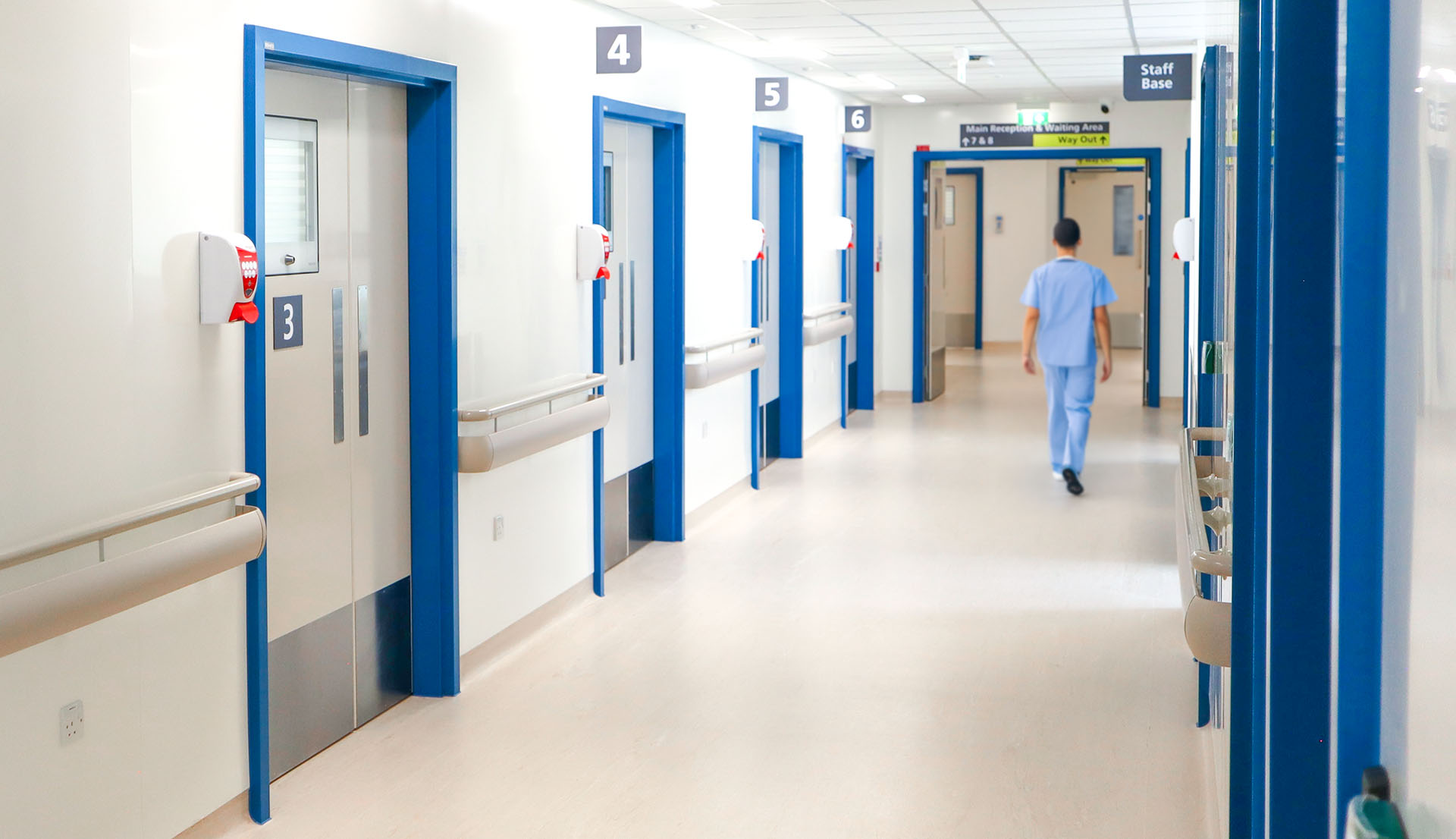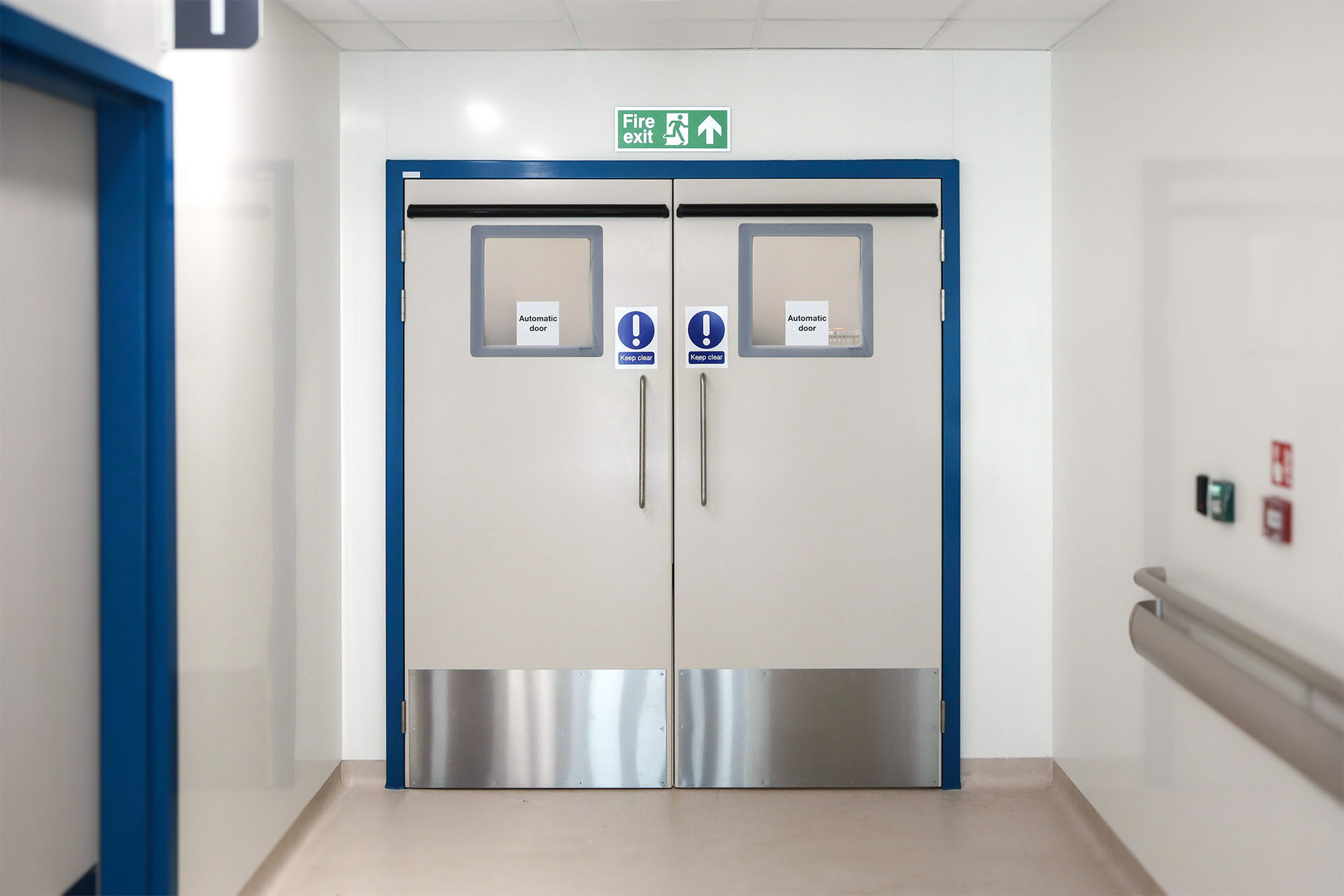Hospital fire doors: purpose, fire-ratings & compliance

Hospital fire doors are crucial for safety and compliance in healthcare. They prevent fire and smoke from spreading, allowing safe evacuation. This article covers their purpose, fire ratings, and standards to meet.

Key takeaways
-
Hospital fire doors play a crucial role in creating safe zones, containing fires and smoke, and facilitating evacuation for patients and staff during emergencies. They are a vital part of fire safety protocols followed by healthcare providers, including the NHS, to ensure patient and staff safety across hospitals and healthcare facilities.
-
Hospital fire doors play a crucial role in creating safe zones, containing fires and smoke, and facilitating evacuation for patients and staff during emergencies.
-
Fire doors must adhere to stringent safety standards and certifications, including fire resistance ratings of FD30 or FD60, to ensure effectiveness and compliance in healthcare facilities.
-
Regular inspections and professional installation are essential for maintaining the functionality and hygiene of fire doors, ensuring they continue to protect patients and comply with safety regulations.
Importance of hospital fire doors
Fire doors, such as Hygidoor, are often the unsung heroes of fire safety in hospitals. Their primary function is to create safe zones, protecting vulnerable individuals during emergencies by preventing or delaying the spread of fires and smoke. This containment is critical in healthcare settings where mobility may be compromised, ensuring that patients and staff have the time needed to evacuate safely.
The fire resistance of hospital fire doors is another critical aspect. These doors are specifically designed to:
-
Withstand fire for a certain period, typically either 30 or 60 minutes, providing a vital window for evacuation and emergency response
-
Contain the fire to specific areas, limiting property damage
-
Facilitate easier access for emergency responders
Fire doors are essential for protecting evacuation routes in hospitals. Compartmentalising the building, these doors keep escape routes clear of smoke and fire, ensuring a safe passage for patients and staff during emergencies. In essence, fire doors are a critical component of a hospital’s fire protection strategy, safeguarding lives and property.
Fire safety standards for healthcare facilities

Pictured above, is Hygidoor tested to destruction. Read more about our approach to fire compliance.
Meeting fire safety standards is non-negotiable in healthcare facilities. The HTM 05-01 and Health Building Notes emphasise the importance of compartmentation in hospitals, ensuring that fire and smoke are contained within designated areas to protect patients and staff. This approach is critical in maintaining a safe environment in the event of a fire and to stand by the necessary protocols.
Hospital fire doors must meet stringent certification standards such as British Standard 476 Part 22 or BS EN 1634-1 to ensure their effectiveness during a fire. Certification by accredited organisations provides assurance of quality and performance, ensuring that the fire doors installed in your facility are tested and up to the high standard required for the task.
Most hospital fire doors are rated for either 30 or 60 minutes of fire resistance, providing critical time for evacuation and emergency response. Promptly having any damaged fire doors repaired is necessary to maintain their effectiveness and ensure patient safety.
The integrity of fire door seals is also of paramount importance. These seals play a crucial role in preventing the spread of fire and smoke, and any damage must be addressed immediately to maintain their effectiveness and control. Regular inspections and maintenance are crucial in ensuring that fire doors continue to meet safety standards and provide the necessary protection in a fire emergency.
 Choosing the right fire doors for hospitals
Choosing the right fire doors for hospitals
Selecting the right fire doors for hospitals involves considering several factors to ensure they meet the required standards and are fit for purpose. These healthcare doorsets must endure constant foot traffic and frequent physical impacts typical in busy healthcare settings.
Selecting fire doors involves considering:
-
Their fire ratings, with most hospital fire doors requiring FD30 or FD60 ratings to provide adequate fire protection.
-
Components such as intumescent seals that expand when exposed to heat, providing extra fire resistance.
-
Certification to ensure compliance with fire safety regulations.
Fire resistance ratings
The fire resistance rating of a hospital fire door is a critical factor in ensuring fire safety. Fire doors are primarily categorised as FD30 or FD60, indicating their ability to withstand fire for 30 or 60 minutes, respectively. This rating provides essential time for evacuation and can mean the difference between life and death in a fire emergency.
Intumescent seals are another important feature of fire-rated doors. These seals expand when exposed to heat, providing additional fire resistance and helping to prevent the spread of fire and smoke. Selecting fire doors with the appropriate fire resistance rating and features is vital for the safety of patients, staff, and property.
Hygiene considerations
In healthcare environments, hygiene is as critical as fire safety. Hospital fire doors should be finished in materials like Trovex PVC, which create a hygienic and easy-to-clean surface. Damaged fire doors can harbour dirt and bacteria, compromising hygiene and posing a risk to patients.
Flush vision panels are another essential feature for maintaining hygiene:
-
Unlike beaded panels, which can trap dirt and bacteria,
-
Flush panels are easier to clean and maintain,
-
Ensuring that hygiene standards are not compromised, including the use of kick plates and push plates.
Selecting fire doors for healthcare facilities and other healthcare settings requires consideration of both fire safety and security when choosing fire doors to effectively protect patients and staff, as well as a sense of responsibility.
Installation and maintenance of hospital fire doors
Proper installation and maintenance of hospital fire doors are crucial to ensure they function correctly during a fire. Certified professionals must install fire doors to meet safety regulations and ensure their effectiveness. Trovex’s specification team offers advice and assistance in the installation process, ensuring that fire doors are installed correctly.
Durability is another critical factor for hospital fire doors due to frequent use and potential impacts. Regular inspections and maintenance are essential to keep hard wearing fire doors in good condition and ensure they continue to provide the necessary protection in a fire emergency.
Professional installation
The installation of hospital fire doors should only be carried out by qualified professionals, such as a contractor, familiar with relevant standards. Certification by third-party accreditation schemes like BM TRADA Q-Mark, BWF Certifire, and IFC Certification is recommended to ensure compliance with safety standards.
Certified professionals ensure fire doors perform as intended during a fire and are installed correctly. This step is crucial in maintaining the safety and integrity of healthcare facilities.
Regular Inspections
Regular inspections of fire doors are essential for maintaining their effectiveness. These inspections are a legal requirement to ensure that fire doors remain functional and compliant with safety standards. Well-maintained fire doors ensure compliance with fire safety regulations and protect patients and staff.
Inspections are vital for maintaining hygiene standards. Damaged fire doors can harbour dirt and bacteria, compromising the cleanliness of healthcare environments. According to BS 8214: 2008, fire doors should be inspected at least twice a year for damage and performance.
The frequency of inspections should be based on the traffic in the area, with high-traffic areas requiring more frequent checks. Inspections should identify any structural damage, such as cracks, dents, and tears, that could compromise the door’s effectiveness. A structured inspection plan maintains the safety and functionality of hospital fire doors.
It’s essential to stay vigilant and proactive in fire safety measures. Regular inspections, timely repairs, and choosing the right fire doors can make a significant difference in protecting lives and property. Make sure your hospital’s fire doors meet the highest safety and hygiene standards to provide the best protection for everyone in your facility.



